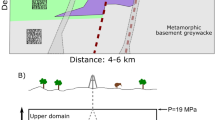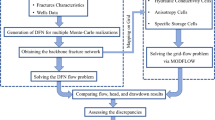Abstract
The karstogenesis of a synthetic aquifer is analyzed as a function of the matrix permeability and the fracture density affecting the carbonate reservoir. The synthetic carbonate aquifer generation results from numerical simulations based on Discrete Fracture Network (DFN) and groundwater flow simulations. The aim is to simulate karstogenesis processes in an aquifer characterized by a fracture network, while matching field reality and respecting geometrical properties as closely as possible. DFN are simulated with the soft REZO3D that allows the generation of 3-D realistic fracture networks, especially regarding the relative position of fractures that control the overall network connectivity. These generated DFN are then meshed and considered to perform groundwater flow simulation with the model GroundWater (GW). At each time step and for each fracture element, flow velocity and the mean groundwater age are extracted and used in an analogical dissolution equation that computes the aperture evolution. This equation relies on empirical parameters calibrated with former speleogenesis studies. In this paper, karstogenesis simulations are performed using fixed-head hydraulic boundary conditions within a single stratum as a function of two fracture density settings. The results are interpreted in terms of head fields, mean groundwater age distributions; while total flow rate and average aperture are analyzed as a function of time. The effect of fracture density and rock matrix permeability are then assessed.








Similar content being viewed by others
References
Bakalowicz M (2006) Importance of regional study site conditions in elaborating concepts and approaches in karst science. Geol Soc Am Spec Pap 404:15–22. doi:10.1130/2006.2404(02)
Bauer S (2003) Modeling of karst aquifer genesis: influence of exchange flow. Water Resour Res 39:1285–1297. doi:10.1029/2003WR002218
Bauer S, Liedl R, Sauter M (2000) Modelling of karst development considering conduit-matrix exchange flow. In: Proceedings of the ModelCARE’99 conference; calibration and reliability in groundwater modelling; coping with uncertainty, vol 265. IAHS-AISH Publication, Zürich, pp 10–15
Bloomfield JP, Barker JA (2005) MOPOD: a generic model of porosity development. Geol Soc Lond Spec Publ 249:73–77. doi:10.1144/GSL.SP.2005.249.01.06
Bloomfield JP, Barker JA, Robinson N (2005) Modeling fracture porosity development using simple growth laws. Ground Water 43:314–326
Cornaton FJ (2003) Deterministic models of groundwater age, life expectancy and transit time distributions in advective-dispersive systems (Ph.D. thesis). University of Neuchâtel, Neuchâtel, Switzerland
Cornaton FJ (2007) Ground water (GW): a 3-D ground water flow, mass transport and heat transfer finite element simulator. University of Neuchâtel, Neuchâtel
Cornaton F, Perrochet P (2006a) Groundwater age, life expectancy and transit time distributions in advective–dispersive systems; 2. Reservoir theory for sub-drainage basins. Adv Water Resour 29:1292–1305
Cornaton F, Perrochet P (2006b) Groundwater age, life expectancy and transit time distributions in advective–dispersive systems: 1. Generalized reservoir theory. Adv Water Resour 29:1267–1291
Cornaton FJ, Park Y-J, Normani SD, Sudicky EA, Sykes JF (2008) Use of groundwater lifetime expectancy for the performance assessment of a deep geologic waste repository: 1. Theory, illustrations, and implications. Water Resour Res 44:W04406. doi:10.1029/2007WR006208
Dörfliger N, Fleury P, Ladouche B (2009) Inverse modeling approach to allogenic karst system characterization. Ground Water 47:414–426. doi:10.1111/j.1745-6584.2008.00517.x
Dreybrodt W (1996) Principles of early development of karst conduits under natural and man-made conditions revealed by mathematical analysis of numerical models. Water Resour Res 32:2923–2935
Dreybrodt W, Eisenlohr L (2000) Limestone dissolution rates in karst environments. In: Klimchouk A, Ford D, Palmer A, Dreybrodt W (eds) Speleogenesis: evolution of karst aquifers. National Speleological Society, Huntsville
Dreybrodt W, Gabrovsek F, Romanov D (2005) Processes of speleogenesis: a modeling approach, Karst Research Institute, ZRC SAZU, Postojna, Slovenia
Fleury P, Ladouche B, Conroux Y, Jourde H, Dörfliger N (2009) Modelling the hydrologic functions of a karst aquifer under active water management—the Lez spring. J Hydrol 365:235–243
Ford DC, Williams PW (2007) Karst hydrogeology and geomorphology. Wiley, Chichester
Jeannin PY (1996) Structure et comportement hydraulique des aquifères karstiques. Université de Neuchâtel, Neuchâtel
Josnin J-Y, Jourde H, Fenart P, Bidaux P (2002) A three-dimensional model to simulate joint networks in layered rocks. Can J Earth Sci 39:1443–1455
Jourde H (1999) Simulation d’essais de puits en milieu fracturé à partir d’un modèle discret basé sur des lois mécaniques de fracturation; validation sur sites experimentaux. Simulation of well testing in fractured media using a discrete model based on the mechanical laws of fractures; validation on experimental sites (Ph.D. thesis). Universite Montpellier II, Sciences et techniques du Languedoc, Montpellier, France
Jourde H, Cornaton F, Pistre S, Bidaux P (2002) Flow behavior in a dual fracture network. J Hydrol 266:99–119
Jourde H, Fenart P, Vinches M, Pistre S, Vayssade B (2007) Relationship between the geometrical and structural properties of layered fractured rocks and their effective permeability tensor. A simulation study. J Hydrol 337:117–132
Kaufmann G (2003) A model comparison of karst aquifer evolution for different matrix-flow formulations. J Hydrol 283:281–289
Kaufmann G, Braun J (1999) Karst aquifer evolution in fractured rocks. Water Resour Res 35:3223–3238
Kaufmann G, Braun J (2000) Karst aquifer evolution in fractured, porous rocks. Water Resour Res 36:1381–1391
Kaufmann G, Romanov D, Hiller T (2010) Modeling three-dimensional karst aquifer evolution using different matrix-flow contributions. J Hydrol 388:241–250. doi:10.1016/j.jhydrol.2010.05.001
Kiraly L, Jeannin P-Y, Sauter M (1998) Introducing to karst modelling; modelling in karst systems. Bull d’Hydrogeol 16:1–6
Klimchouk AB, Ford DC (2000) Types of karst and evolution of hydrogeologic setting. In: Klimchouk A, Ford D, Palmer A, Dreybrodt W (eds) Speleogenesis: evolution of karst aquifers. National Speleological Society, Huntsville
Lafare A (2011) Modélisation mathématique de la spéléogenèse: une approche hybride à partir de réseaux de fractures discrets et de simulations hydrogéologiques (thèse de doctorat, Eaux Continentales et Société - UM2). Université de Montpellier 2, Montpellier, France
Lafare A, Jourde H, Leonardi V, Pistre S, Dörfliger N (2009) Speleogenesis of Mediterranean karsts; a modelling approach based on realistic fracture networks. In: Hypogene speleogenesis and karst hydrogeology of artesian basins; proceedings, Ukrainian Institute of Speleology and Karstology Special Paper. Presented at the International conference; hyogene speleogenesis and karst hydrogeology of artesian basins, Ukrainian Institute of Speleology and Karstology, Simferopol, Ukraine (UKR), Chernivtsi, Ukraine, pp 75–81
Liedl R, Sauter M, Hueckinhaus D, Clemens T, Teutsch G (2003) Simulation of the development of karst aquifers using a coupled continuum pipe flow model. Water Resour Res 39:11
Mangin A (1975) Contribution à l’étude hydrodynamique des aquifères karstiques (Ph.D. thesis). Université de Dijon, Dijon, France
Mazzilli N, Guinot V, Jourde H (2012) Sensitivity analysis of conceptual model calibration to initialisation bias. Application to karst spring discharge models. Adv Water Resour 42:1–16. doi:10.1016/j.advwatres.2012.03.020
Palmer AN (1991) Origin and morphology of limestone caves. Geol Soc Am Bull 103:1–21
Palmer A (2000) Digital modeling of individual solution conduits. In: Klimchouk A, Ford D, Palmer A, Dreybrodt W (eds) Speleogenesis: evolution of karst aquifers. National Speleological Society, Huntsville
Palmer AN (2001) Dynamics of cave development by allogenic water. Acta Carsologica 30(2):14–32
Romanov D, Dreybrodt W, Gabrovšek F (2002) Interaction of fracture and conduit flow in the evolution of karst aquifers. In: Martin JB, Wicks C, Sasowsky ID (eds) Proceedings of the symposium on karst aquifers: florida and related environments. Presented at the Symposium on Karst Aquifers: Florida and Related Environments, Karst Waters Institute, Charles Town, WV, pp 1–6
Sauter M (1992) Quantification and forecasting of regional groundwater flow and transport in a karst aquifer (Gallusquelle, Malm, SW. Germany) (Ph.D. thesis). Eberhard Karls Univ. Tübingen, TGA, C13, Tübingen, Germany
Tritz S, Guinot V, Jourde H (2011) Modelling the behaviour of a karst system catchment using non-linear hysteretic conceptual model. J Hydrol 397:250–262. doi:10.1016/j.jhydrol.2010.12.001
Acknowledgements
The authors thank the Conseil Régional of Languedoc Roussillon, as well as the BRGM and Carnot fund, for the financial support of this work carried out in the framework of the Antoine Lafare’s Ph.D. The authors would also like to thank Fabien Cornaton, presently Director, GMC at DHI-WASY GmbH (Germany), the CHYN of the University of Neuchâtel, (Switzerland), for permitting the using of the GroundWater modeling software, and for precious advices.
Author information
Authors and Affiliations
Corresponding author
Rights and permissions
About this article
Cite this article
Lafare, A., Jourde, H., Léonardi, V. et al. Mathematical modeling of karstogenesis: an approach based on fracturing and hydrogeological processes. Carbonates Evaporites 32, 391–401 (2017). https://doi.org/10.1007/s13146-017-0337-6
Accepted:
Published:
Issue Date:
DOI: https://doi.org/10.1007/s13146-017-0337-6




